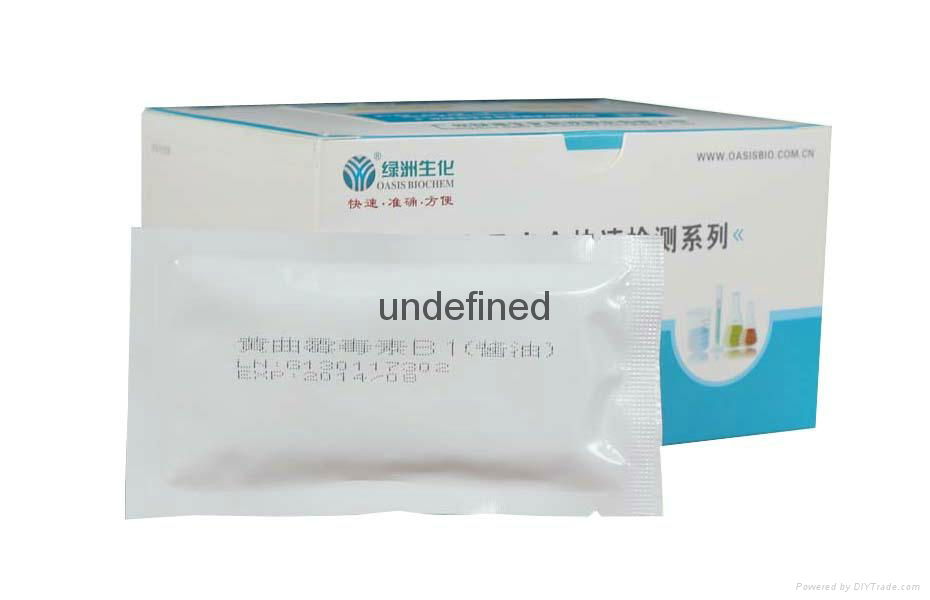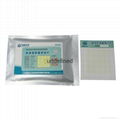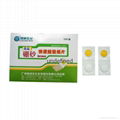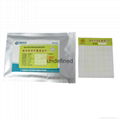| Model: | 32.4066 |
|---|---|
| Brand: | OASIS |
| Origin: | Made In China |
| Category: | Chemicals / Other Chemicals |
| Label: | count plate , food safety detect , rapid detection |
| Price: |
US $102
/ pc
|
| Min. Order: | 1 pc |
Product Description
Aflatoxin B1 is one kind of fungaltoxin which is the metabolite of aspergillus flavus and aspergillus living in food and fodders. Up to now, 17 kinds of Aflatoxins have been separated and identified. The main kinds are Aflatoxin B1, B2, G1, G2, and M1, M2 which are the metabolite of B1 and B2. Most natural pollution of food are contaminated by Aflatoxin B1,which has strong toxicity and has been identified as one kind of cancerogens by World Health Organization.
With immunochromatography, aflatoxin B1 detecting card can rapidly detect the residue of aflatoxin B1 in food products and their fermentation products. With the features of easy operation,short time detection and directly reading result, it is suitable for the rapid detection of the residue of aflatoxin B1 on site for enterprises in different fields, testing organization.
1. Application scope
It is suitable for rapid detection of Aflatoxin B1 residue in food products (such as coin, rice, beans, peanuts) and their fermentation products (such as soybean sauce, vinegar, edible oil, rice wine).
2. Lower detection limit: 1ppb (μg/kg)
3. Composition:
3.1 Aflatoxin B1 rapid detecting card (10pcs, including microwell)
3.2 10 pcs of 15ml centrifuge tubes
3.3 1 bottle of sample diluents
3.4 1 bag of Na2CO3 powder
3.5 10 pcs of suckers.
3.6 1 operation manual.
4. Specification
10times/box
5. The reagent and utensil needed but not included:
Small glass cup, pipettor and timer, n-hexane, ethyl acetate, nitrogen blow drying machine, electric blower.
6. Reagent preparation:
For soybean sauce and vinegar detection: prepare 50 mM Na2CO3 solution by using 100ml ultrapure water to dissolve the bag of Na2CO3 powder.
7. Sample treatment
7.1 Grains and fodders:
7.1.1 Select more than 5g representative sample and then smash them. Weigh 2.0g the smashed sample into 15ml centrifuge tube.
7.1.2 Add 2ml pure water and 8ml ethyl acetate into the above centrifuge tube. Cover the tube tightly.Shake it evenly for 5mins and let it stand for 1min.
(Note: If the supernatant is less than 3ml, centrifuge it at 4000rpm for 1min)
7.1.3 Transfer 3ml supernatant into small glass cup with a disposable sucker. Dry it using electric blower (temperature should not be too high) or 60℃nitrogen blow drying machine.
7.1.4 After drying, add 4 drop of sample diluents (about 200μl) to dissolve the residue material. Shake it to let it blend evenly to be as measured object.
7.2 Edible oil
7.2.1 Weigh 2.0g oil sample into 15ml centrifuge tube.
7.2.2 Add 8ml n-hexane and 4ml pure water, cover the tube tightly. Shake it evenly for 3mins). Suck away the above supernatant carefully.
7.2.3 Add 4ml ethyl acetate into centrifuge and cover it tightly. Shake it evenly for 5mins and let it stand or centrifuge it for 1min.
7.2.4 Transfer 3ml supernatant into a clean small glass cup or other small container, dry it using electric blower (temperature should not be too high) or 60℃nitrogen blow drying machine.
7.2.5 After drying, add 4 drop of sample diluents (about 200μl) to dissolve the residue material. Shake it to let it blend evenly to be as measured object.
7.3 Soybean sauce, vinegar:
7.3.1 Weigh 2ml sample into 15ml centrifuge tube
7.3.2 Add 4ml ethyl acetate into centrifuge tube, and then cover it tightly. Shake it evenly for 5mins and let it stand for 1min.
7.3.3 Transfer supernatant into another 15ml centrifuge tube
7.3.4 Add 2ml 50 mM Na2CO3 solution (It is s ested that use NaOH solution to adjust the PH value to 6.0- 6.8. Shake it evenly for 3mins.
7.3.5 Transfer 3ml supernatant into a clean small glass cup or other small container, dry it using electric blower (temperature should not be too high) or 60℃nitrogen blow drying machine.
7.3.6 After drying, add 4 drop of sample diluents (about 200μl) to dissolve the residue material. Shake it to let it blend evenly to be as measured object.
7.4 Brewed wine
7.4.1 Weigh 2ml sample into 15ml centrifuge tube
7.4.2 Add 4ml ethyl acetate into centrifuge tube, and then cover it tightly. Shake it evenly for 5mins.
7.4.3 Let it stand for 1-2 minutes to make it layer.
7.4.4 Transfer 3ml supernatant into a clean small glass cup or other small container, dry it using electric blower (temperature should not be too high) or 60℃nitrogen blow drying machine.
7.4.5 After drying, add 4 drop of sample diluents (about 200μl) to dissolve the residue material. Shake it to let it blend evenly to be as measured object.
8. Detecting steps
8.1 Make detecting card, microwell and sample solution to be detected return to room temperature before using them.
8.2 Take out the detecting card from package, lay it flatwise.
8.3 Suck 100μl measured liquid to microwell with pipette, blow repeatedly for 3-5times to let it blend evenly. Let it stand for 5mins, and then transfer the liquid to the added hole in the detecting card with disposable sucker.
8.4 Start timing after transferring them, and observe the result at 5-8mins. It is invalid if the result is read after 8mins.
Pay attention that the dropper which is used for adding sample solution should be disposable to avoid cross contamination.
9. Result
9.1 Negative result: there are two red lines in both T area and C section.
It means that there is not any aflatoxin B1 or the content of aflatoxin B1 is under the lower detection limit.
9.2 Positive result: there is only one red line and it appears in C section.
It means there may be aflatoxin B1 in the sample.
9.3 Invalid result: it is invalid or false if there is not any red line appearing in the C section. In this case, read the operation manual carefully and use a new detecting card to retest.
10. Boundedness of detecting method
10.1 This detecting method is only for qualitative screening of aflatoxin B1 in the sample, and it can’t determine the exact content.
10.2 This detecting method is only as preliminary detection of Aflatoxin B1. Using gas chromatography or gas mass spectrometry to confirm the result if necessary.
10.3 It will get wrong result if operating improperly or there is interfering substance in the sample.
11. Matters need attention
11.1 Check the aluminum foil bag whether is damaged before doing the detection. If it is damaged, it can’t be used for the detection in order to avoid false result.
11.2 The detecting card should be used for the detection within one hour after taking out from the aluminum foil bag. Because it will be affected by damp and lose efficacy if exposed to air for a long time.
11.3 Keep certain humidity in experiment environment and take it shelter from the wind. Avoid doing the test at high temperature.
11.4 Preserve the detecting cards from damp if store them at room temperature. And the detecting cards which are stored at low temperature can’t be used until they return to room temperature.
11.5The detecting card is disposable and should be used within validity period.
12. Storage condition and validity period
12.1Storage condition: temperature (4-30℃) , shade and dried condition without light
It can’t be cryopreserved.
12.2Validity period: one year.
Member Information
| Guangdong Dayuan Oasis Food Safety Technology Co.,Ltd | |
|---|---|
| Country/Region: | Guang Dong - China |
| Business Nature: | Manufacturer |
| Phone: | 13745444520 |
| Contact: | Phoebe Zhang (Executive of Foreign) |
| Last Online: | 17 Mar, 2017 |







